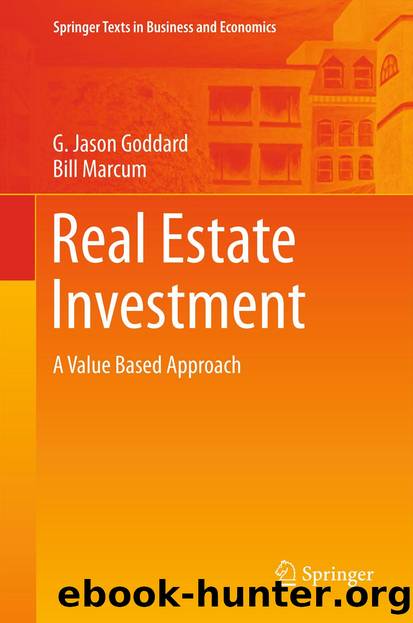Real Estate Investment by G. Jason Goddard & Bill Marcum

Author:G. Jason Goddard & Bill Marcum
Language: eng
Format: epub
Publisher: Springer Berlin Heidelberg, Berlin, Heidelberg
For example, net income from any S-Corporation will flow to the schedule E part II of the personal tax return. This is where income from pass-through entities is reported. Letâs assume that Vic and Sal Tyan own Tyan Investments, LLC on an equal basis. If the last yearâs taxable income was $410,000, then each shareholder would receive a pass-through on their personal schedule E part II of $205,000. This figure would flow to the front page of the personal federal tax return and report on line 17 of the US form 1040 (IRS 2011). This may also flow to the personal schedule A, which itemizes state and local taxes as well as itemized deductions. This income, along with any other personal income, would serve as the basis for the determination of the marginal tax rate for each investor.
The primary point of interplay between the personal and business tax returns revolves around the schedule K. The schedule K aggregates the net income, equity contributions, equity distributions, interest and dividends, and capital gains during the calendar year. The schedule K-1 is prepared for each shareholder and serves as the basis of taxation at the personal level. Thus the financial performance of the corporation is pro-rated via the K-1 schedule. Returning to our previous example, if Tyan Investmentsâ operating account produced annual interest income of $5,000, the schedule K-1 would itemize interest income of $2,500 for each shareholder, and this income would report on the personal schedule B. The shareholder will be taxed on the interest received from the company checking account as well as on any dividends received from the pass-through entity during the tax year.
From the lenderâs perspective, the income of $207,500 for each shareholder does not necessarily mean that the individuals actually received this income. The tax returns only indicate that the individuals were responsible for taxation at this amount owing to their ownership in the corporate entity. The schedule K-1 can be utilized to view actual partner draws and contributions during the calendar year.
The role of the small corporation, especially the limited liability company, has been criticized recently for creating an imbalance between risks and rewards given the partial shelter from personal liability for the shareholders (Sinn 2010). As the name implies, shareholders of a limited liability company are only responsible, or limited, to the amount of their ownership, or equity investment, should the company become entangled in legal or other disputes. The prevalence of limited liability companies in Germany (GMBH: Gesellschaft mit Beschränkter Haftung), France (SARL: Société à Responsabilité Limitée), England (LLP: limited liability partnership), and many other nations across the globe bodes well for its continued use.
Download
This site does not store any files on its server. We only index and link to content provided by other sites. Please contact the content providers to delete copyright contents if any and email us, we'll remove relevant links or contents immediately.
Rich Dad Poor Dad by Robert T. Kiyosaki(6192)
Pioneering Portfolio Management by David F. Swensen(6089)
How To Win Friends and Influence People by Dale Carnegie(4341)
The Money Culture by Michael Lewis(3857)
The Dhandho Investor by Mohnish Pabrai(3573)
The Wisdom of Finance by Mihir Desai(3538)
Liar's Poker by Michael Lewis(3230)
The Intelligent Investor by Benjamin Graham Jason Zweig(2939)
The ONE Thing by Gary Keller(2924)
Mastering Bitcoin: Programming the Open Blockchain by Andreas M. Antonopoulos(2897)
Fooled by Randomness: The Hidden Role of Chance in Life and in the Markets by Nassim Nicholas Taleb(2870)
Rich Dad Poor Dad: What The Rich Teach Their Kids About Money - That The Poor And Middle Class Do Not! by Robert T. Kiyosaki(2840)
Investing For Dummies by Eric Tyson(2802)
How to Win Friends and Influence People by Dale Carnegie(2800)
How to Day Trade for a Living: Tools, Tactics, Money Management, Discipline and Trading Psychology by Andrew Aziz(2791)
Market Wizards by Jack D. Schwager(2548)
Zero Hour by Harry S. Dent Jr. & Andrew Pancholi(2538)
How to Pay Zero Taxes, 2018 by Jeff A. Schnepper(2505)
Rich Dad's Guide to Investing by Robert T. Kiyosaki(2416)
